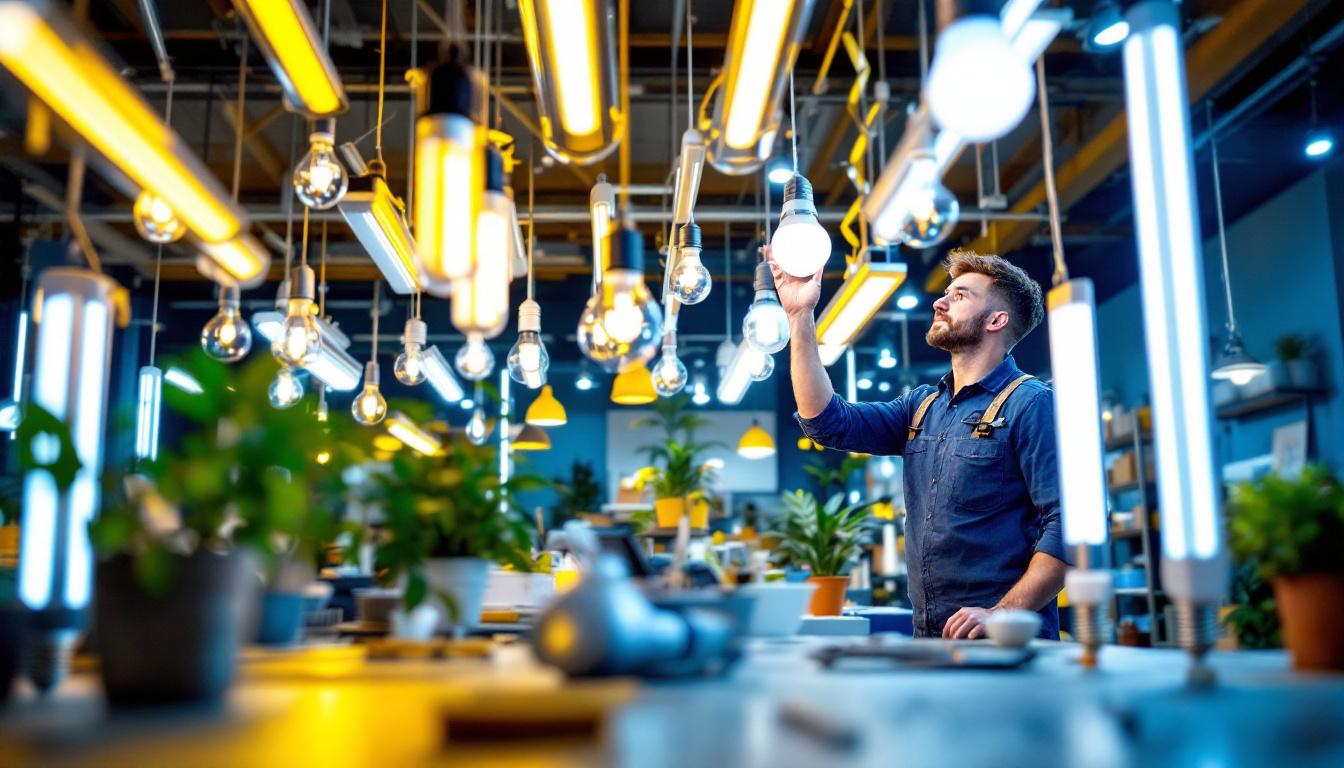
In the ever-evolving world of lighting technology, LED products have emerged as a game changer for both residential and commercial applications. As a lighting contractor, staying updated on the latest trends, products, and installation techniques is crucial for delivering quality service to clients. This article provides quick tips and insights into LED lighting products that can enhance your expertise and efficiency on the job.
LED, or Light Emitting Diode, is a semiconductor device that emits light when an electric current passes through it. Unlike traditional incandescent bulbs, LEDs are more energy-efficient, have a longer lifespan, and produce less heat. Understanding these fundamental aspects of LED technology is essential for any lighting contractor.
One of the most significant advantages of LED lighting is energy efficiency. LEDs consume significantly less power compared to incandescent and fluorescent lights, leading to lower electricity bills for clients. This efficiency also translates into a reduced carbon footprint, making LEDs an environmentally friendly choice. Moreover, the ability to dim LEDs without losing efficiency further enhances their appeal, allowing for customizable lighting solutions that can adapt to various moods and settings.
Another key benefit is longevity. LED lights can last up to 25,000 hours or more, which means fewer replacements and maintenance visits for contractors. This durability not only saves time but also enhances customer satisfaction, as clients appreciate the long-term value of their investment. Additionally, the robust nature of LEDs makes them less prone to breakage compared to traditional bulbs, which is particularly advantageous in high-traffic areas or outdoor settings where durability is paramount.
When selecting LED products, understanding color temperature and Color Rendering Index (CRI) is vital. Color temperature, measured in Kelvin (K), affects the ambiance of a space. For example, a warm white (around 2700K) creates a cozy atmosphere, while cool white (around 5000K) is ideal for workspaces. Furthermore, the versatility of LED technology allows for a wide range of color temperatures, enabling designers and contractors to create specific environments tailored to the needs of the occupants, whether it be a calming retreat or an energizing workspace.
CRI measures how accurately a light source displays colors in comparison to natural light. A CRI of 80 or above is generally acceptable for residential applications, while commercial spaces may benefit from a CRI of 90 or higher to enhance product visibility and aesthetic appeal. Understanding the nuances of CRI can also help contractors advise clients on the best lighting solutions for art galleries, retail spaces, and other environments where color accuracy is crucial, ensuring that the true colors of products and artworks are showcased effectively.
Selecting the appropriate LED products for a specific project requires careful consideration of various factors, including application, environment, and client preferences. Here are some tips to guide the selection process.
Different applications require different types of LED products. For instance, outdoor lighting may necessitate weather-resistant fixtures, while indoor applications might focus on aesthetic appeal and energy efficiency. Understanding the specific needs of each application will help in recommending the right products.
Additionally, consider the purpose of the lighting. Task lighting, accent lighting, and ambient lighting all have unique requirements. For example, task lighting should provide adequate illumination for activities such as reading or cooking, while accent lighting can highlight artwork or architectural features. Furthermore, the color temperature of the LEDs can significantly impact the ambiance; warmer tones can create a cozy atmosphere, while cooler tones are often preferred in workspaces for enhanced focus and clarity.
Environmental factors play a crucial role in the selection of LED products. For outdoor installations, factors such as temperature fluctuations, humidity, and exposure to elements should be considered. Choosing products with appropriate IP ratings ensures durability and performance in challenging conditions.
Indoors, factors like ceiling height and room size can influence the choice of fixtures. For high ceilings, pendant lights or track lighting may be more effective, while recessed lighting can create a clean, modern look in smaller spaces. Additionally, the layout of the room should be taken into account; open floor plans may benefit from layered lighting to create depth and dimension, while smaller, enclosed spaces might require more focused lighting solutions to avoid a cluttered feel. It’s also essential to consider energy efficiency and the long-term cost savings associated with LED technology, which can significantly reduce electricity bills and maintenance needs over time.
Proper installation is key to maximizing the performance and lifespan of LED lighting products. Following best practices not only ensures safety but also enhances the overall quality of the installation.
When installing LED fixtures, it is essential to ensure compatibility with existing wiring and dimming systems. Some LED products may require specific types of dimmers to function correctly. Using incompatible dimmers can lead to flickering or reduced lifespan of the LEDs.
Additionally, pay attention to the wattage and voltage requirements of the LED products being installed. Overloading circuits can cause premature failure, while underutilizing the capacity may lead to inadequate lighting levels. It’s also advisable to consult the manufacturer’s specifications for any unique requirements or recommendations, as this can help avoid potential issues during installation. Furthermore, using high-quality wiring and connectors can significantly improve the reliability of the installation, reducing the risk of electrical faults that could compromise safety.
The positioning of LED fixtures can significantly impact the effectiveness of the lighting design. Properly aiming recessed lights, for instance, can help eliminate shadows and enhance the overall illumination of a space. When installing track lighting, consider the focal points and desired ambiance to create a balanced lighting scheme.
For outdoor installations, ensure that fixtures are positioned to minimize light pollution and maximize efficiency. This may involve angling lights away from neighboring properties or using shields to direct light where it is needed most. Additionally, consider the height and angle of outdoor fixtures to optimize their performance. For example, mounting lights too high can diminish their effectiveness, while too low may create glare. It’s also beneficial to assess the surrounding landscape and architecture, as this can influence how light interacts with various surfaces and features, ultimately enhancing the aesthetic appeal of the outdoor space. Thoughtful positioning not only improves functionality but also contributes to the overall atmosphere and safety of the environment.
Regular maintenance is essential for ensuring the longevity and performance of LED lighting systems. Understanding common issues and their solutions can help contractors provide better service to clients.
One common issue with LED lights is flickering, which can be caused by incompatible dimmers, voltage fluctuations, or loose connections. Identifying the root cause is crucial for effective troubleshooting. Regularly checking connections and ensuring compatibility with dimming systems can prevent flickering from occurring.
Another issue may arise from overheating, which can shorten the lifespan of LED fixtures. Ensuring proper ventilation and using fixtures designed for the specific application can help mitigate this problem. Additionally, educating clients about the importance of not covering LED fixtures can prevent overheating.
Establishing a maintenance schedule can help catch potential issues before they escalate. Regular inspections can identify problems such as loose connections, dirt accumulation, or signs of wear. Providing clients with a maintenance plan not only enhances their satisfaction but also positions the contractor as a trusted expert in LED lighting.
In addition to inspections, educating clients on how to care for their LED fixtures can empower them to maintain their lighting systems effectively. Simple tips, such as using a soft cloth for cleaning and avoiding harsh chemicals, can go a long way in preserving the quality of the lights.
The lighting industry is continually evolving, with new technologies and trends emerging regularly. Staying informed about the latest advancements in LED lighting can enhance a contractor’s service offerings and keep them competitive in the market.
Smart lighting solutions are gaining popularity, allowing for greater control and customization of lighting systems. These solutions often integrate with home automation systems, enabling clients to adjust lighting remotely or set schedules for different times of the day.
As a contractor, understanding how to install and configure smart lighting products can provide added value to clients. Familiarizing oneself with popular smart lighting brands and their compatibility with various systems can enhance service offerings and attract tech-savvy customers.
With a growing emphasis on sustainability, energy-efficient solutions are becoming increasingly important. Contractors should stay informed about programs and incentives that promote energy-efficient lighting upgrades, as these can benefit both the contractor and the client.
Additionally, exploring options such as solar-powered LED lights can open up new opportunities for outdoor installations. Understanding the benefits and limitations of these products can help contractors make informed recommendations to clients.
LED lighting products offer numerous benefits, from energy efficiency to longevity, making them an essential component of modern lighting design. By understanding the technology, selecting the right products, following best installation practices, and staying updated on trends, lighting contractors can enhance their services and provide exceptional value to clients.
As the industry continues to evolve, embracing new technologies and innovations will be key to maintaining a competitive edge. By implementing these quick tips, lighting contractors can ensure they are well-equipped to meet the demands of the market and deliver outstanding lighting solutions.
Ready to take your lighting projects to the next level? At LumenWholesale, we provide lighting contractors with the highest quality, spec-grade LED lighting products at unbeatable wholesale prices. Say goodbye to local distributor markups and hello to a vast selection of reliable, high-performance lighting that meets the strictest industry standards. With free shipping on bulk orders, you can stock up on premium lighting solutions without worrying about hidden fees or compromises. Elevate your service offerings and delight your clients by choosing Wholesale Lighting at the Best Value with LumenWholesale today.

Discover how Arena Horse is revolutionizing the lighting industry for contractors by streamlining processes and enhancing efficiency.

Discover the essentials of light fixtures with insights tailored for lighting contractors.

Discover the step-by-step process of changing the K value in 4ft LED lights and learn how this simple adjustment can significantly enhance efficiency for lighting contractors.

Discover the essential facts about T5 fluorescent light bulbs that every lighting contractor needs to know.